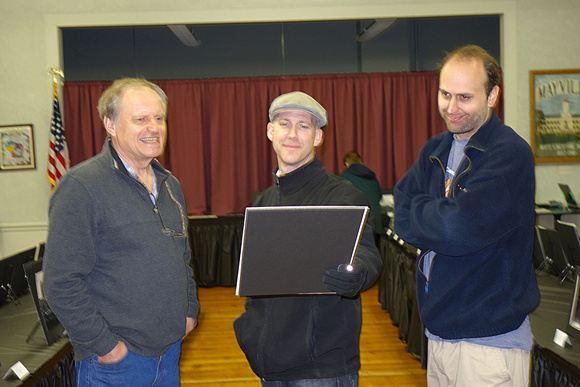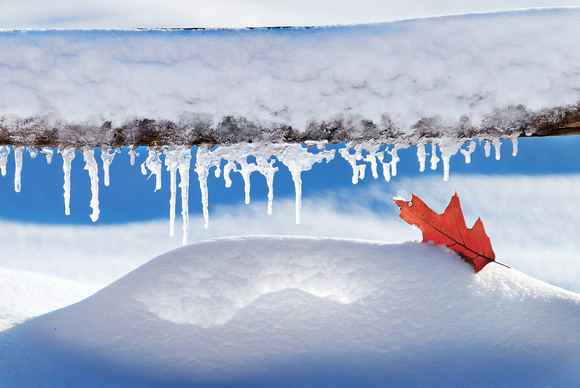Judging the Edgar G. Mueller Photo Contest
I love photography and being involved in as much of it as I can, so judging the Edgar G. Mueller photo contest for the Limestone School Museum in Mayville this April was a good opportunity to keep my hands in the craft and potentially educate others about photography.


On April 23, 2013 judging of the Edgar Mueller photo contest took place at the Mayville Limestone School Museum. Shown, l to r, studying a photo as a possible winner are photographers Terrill Knaack of Sunny Point Studio, Beaver Dam; Patrick Flood, chief photographer at the Fond du Lac Reporter; and Joel Nisleit of Joel Nisleit Photography of Horicon. Photo courtesy of Don Bauer, president of the Mayville Limestone School Museum.
I can't share details about specific images, but I will share some general observations that might help you create better images and understand the judging process.
First, let's take a look at the process. Three photographers took part in the judging. We browsed the images quickly to get an overview and then took more time to rate each one from 1 to 10 on a sheet, sometimes using decimals. Color and black-and-white are done separately. The individual judges' sheets were anonymously put into a spreadsheet program, and the 10 photos with the highest scores were considered for final judging. The judges didn't know which images would be in the top 10. From the top 10 we then ranked the top five images in order.
The judging process is fun because each judge has a different background and despite us agreeing on most images, we differed in some areas when it came to which image should take which place and why we felt that way. Sometimes it was two against one and usually we found good reason to capitulate or simply let the majority rule. One judge may like an aspect of an image that doesn't impress another judge, and we talked through those points.
The process takes about 1.5 to two hours because choosing the top five in order is what takes the most time and what sparks the most discussion. Usually first place is easy, but then differentiating between second and third down through fifth can be challenging. Choosing best of show was relatively simple for us, but that doesn't mean it's simple in every contest. Several photos were close contenders, but we each found a lot of merits in the winning image.
That's the process, but there's more to learn about photography than just how images are chosen. Why are certain images chosen, and why do we look so quickly through most of the images?
From my perspective, the first images to be cut are the snap shots, the ones that show the least imagination with lighting, composition and the least technical perfection. These constitute about a third of the entries. In these images, use of flash is obvious, as are exposure problems and uninteresting composition and subject. These images show us nothing new. Realize that we've been photographing professionally for years and we're looking for something we haven't seen before. We've seen hundreds of sunset shots, hundreds of lighthouses, thousands of kids and puppies looking at the camera. Few images are new.
Most images fall in the average group, the scores of about 4 to 6. In these images, common ideas are reasonably well represented, such as an insect on a leaf, a close-up of a water drop, a sunset, a pattern or texture. They're often well exposed and composed to meet the minimum standards but they don't advance the idea or cliche or there are other images doing the basic stuff much better.
The highest rated images show some level of understanding and control of the essential elements of photography, including light, composition and exposure -- even if it's unintentional -- and they also offer mood, dimension, color, sharpness, even story. Tones are rich. Details are sharp. Composition is on target. There's impact and resonance. Some of these are simply common ideas taken to a higher level through technique or light, and some offer us something relatively new or force us to look twice.
What surprised me at the reception was how many photographers didn't seem to be very involved in the crafting of their winning images. They just saw something they liked and took it. It seemed like they didn't purposefully craft what impressed the judges, even if the photos suggested they did, but instead they captured a scene because something about it spoke to them. Of course, it was clear that also several photographers did understand and control what they were doing.
What I want you to realize is photography can be much better if you do it on purpose, if you understand and control it. I realize of course that this is a contest for amateurs. We don't expect every image to completely demonstrate all of the merits we would look for in professional work. I don't know if any images received a perfect 10 but I didn't rate any that highly. For me the rating became somewhat of a relative system, where I got an idea of what was average and what was above average, and I rated certain images higher or lower depending on how many merits they demonstrated and how well they demonstrated them. But you can learn to do on purpose what will make your images better.
To help you get your images in the winning group next time, I can't tell you what a winning photograph will be or what elements it will contain because a winning photograph shouldn't be predictable. I shouldn't be able to describe it to you. Ansel Adams said something like there are no rules for good photos; there are only good photos. It should communicate the reason for itself.
The strongest piece of advice I can give you is think of a photograph as a story told by light. Look for light. Study light. Understand light. Capture light. Light is mystery. It illuminates, but shadows define. Sometimes a shadow says as much as light. Light is a big subject and it's the pursuit of every professional.
Understand and learn to control fundamentals like exposure, subject, composition, form, mood, color and tone psychology, story, creativity, impact. Yes, the fundamentals and "rules" actually matter and they matter to pros every day. Perfect exposure isn't a mystery to pros, so for us that's not enough. We look for elements in a scene and figure out how to craft them, using fundamentals, into something that resonates as an image. One theme that kept coming up is if something doesn't add to the value of a photograph, it will detract. Images are crafted, usually pre-visualized, and chiseled away at like sculptures. Technique and tools serve vision.
No single concept is a guaranteed win: a sunset, a silhouette, a pattern, a portrait. What we look for is control and something new or different -- a powerful element of light, a mood expressed through color and composition or texture, a story told by the play of light and shadows. It could be a different way of looking at something. The best images have multiple photographic elements captured well and working well together. We want images that show us you understand technique and have used it to craft something memorable.
Better photography comes through learning, practicing and experience. It comes from exploring and understanding, from sharpening your vision and crafting vs. guessing. Images that don't show mastery of fundamentals on some level don't advance to the winning group. Even if you didn't make it good on purpose, recognize what is good and choose those images for entry. If you want to take a good portrait, learn about classical portrait techniques. Study the contemporary masters. If you want to enter a landscape, understand what makes a good landscape. Use fundamentals and put your own take on them. To help place photos, judges pick them apart on their merits. If there are five decent portraits in a contest, we will pick them apart against the standards of classical portraiture and where the photo takes those standards.
A perfect profile? Close. This is what I mean when I talk about quality of light. The light illuminates, but the shadows sculpt. Look at the roundness of the pearls, the chiseled ear, the form and dimension. We see one eye, but no part of the other eye -- classical technique. So what in this profile is not perfect? The eye itself is looking straight ahead, revealing too much of the white. It should be turned 30 degrees toward camera, filling the socket -- classical technique. This was taken of a real bride using only window light.
You can be at the greatest location with the greatest light, but if you don't know how to capture it, you'll end up with a snap shot or worse. I see this at every tourist hot spot (see Haleakala sunrise caption). Photography is not about the best gear. If you have a camera and lens, you have the equipment necessary to take the best images in the world. But the camera and lens by themselves can't make a great image any more than a brush and canvas can paint themselves a masterpiece. It's about who's using the tools.
Feel free to ask me anything about photography or sign up for some mentoring or a workshop. Learning is ongoing. I can teach you what I know, but I can't teach you what I'll know tomorrow. I can help you get past equipment and start realizing your vision or just have more fun with photography.


Strong top and bottom third, and strong lower right third; that's good composition. The eye studies the detail of the icicles, which pop because they're composed against a dark background, and moves around the frame to study the textures of the snow, and the viewer is always drawn to the red; that's called color contrast, in this case the contrast between the blues, whites and red. There's no strong exit point, which is good. Without proper exposure, the subtlety of the light glowing through the snow would be lost and the highlights would easily be blown out.
Comments
improve their skills.


